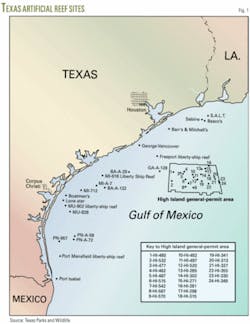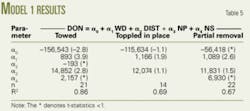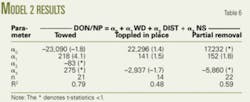Rigs-To-Reef—Conclusion: Texas, Louisiana programs offer similar cost savings
Mark J. Kaiser
Louisiana State University
Baton Rouge
The economics on a structural basis for participating in the Texas artificial-reef program are similar to those of Louisiana’s program. The Louisiana program was discussed in Part 2 of this series (OGJ, Aug. 1, 2005, p. 38).
Texas established its artificial-reef program in 1991, and currently it includes more than 35 permitted reef sites with more than 70 decommissioned platforms.
This concluding part of a three series that started in OGJ, July, 25, 2005, p. 37 summarizes the Texas program and provides quantitative models for determining the cost savings for donating a structure.
Texas program
Resource managers have constructed artificial reefs off Texas for more than 50 years, but the general recognized start of the reef program is 1975-76, when Texas acquired 12 US Navy Liberty ships that formed the basis of several reef sites.
By 1984, Texas had created more than 2,000 artificial-reef areas that contained open-water spoil disposal areas, piers and docks, jetties, and oil and gas well shell pads.1
Other than the liberty ships, however, most materials had little long-term success because storms easily moved or broke them up.2
In 1989, under the guidance of the US National Fishing Enhancement Act (NFEA), the Texas legislature directed the Texas Parks and Wildlife Department to develop the artificial-reef potential offshore Texas. It published its artificial-reef plan in 1991.3
Reef areas
The Texas artificial-reef program (TARP) provides for several permit options.
The Galveston District Corps of Engineers (COE) developed a policy that permits 40-acre reef sites as long as site location and material placement meet the plan guidelines. Each 40-acre site encompasses 1⁄16 of a sq mile (1,320 ft by 1,320 ft) and has room for a cluster of at least nine jacket structures.
The initial donor at a permitted site may topple the structure in place if clearance restrictions are met. The program encourages owners of nearby structures to transport their structures to an existing site to increase its complexity and avoid additional permitting.
Except for reef sites created in the High Island leasing area, all other Texas artificial-reef sites have individual permits (Fig. 1). Under the authority of a general permit from the COE, artificial reefs created in the general permit area do not require a 30-day public comment period.
The permit requires the reef location to be at least 3 miles from another reef site, 2 nautical miles from a safety fairway, and 1,000 ft from an active pipeline.
The location also must have at least 85 ft of water above the highest portion of the structure and must be at least 1⁄2 nautical mile away from any natural hard bottom communities, such as the Flower Garden National Marine Sanctuary in East and West Banks.
Reefs that do not meet these criteria require an individual permit from the COE issued after a 30-day public comment period.
Structure donation
Table 1 shows the number of oil and gas structures donated to the Texas artificial-reef program (TARP) and the money donated. From 1990-2003, companies donated 73 structures to the program. This included 9 three-pile jackets, 39 four-pile jackets, 25 eight-pile jackets, 1 deck, and 1 caisson.
TARP also has received several other donated objects, including clay-shell culverts, tankers, fly-ash blocks, concrete anchors, reef balls, quarry rocks, barges, buoys, net guard pieces, tugboats, and piping,2 but such donations, however, generally provide no savings to the owner.
As of May 2004, the Texas artificial-reef trust fund has accrued about $9.6 million.
Removal methods
Table 2 shows the average donation amount per structure, per donation, and per pile according to removal method and structure type. The data were normalized to ensure consistent comparisons between removals options and structure type.
From 1990-2003, companies towed 32 structures to a reef site, toppled-in-place 16, and partially removed 25.
The average donation varies with the structure type and removal method. For four-pile structures towed to site, the average donation is $17,382/structure vs. $143,107/structure for those toppled-in-place (TIP) and $174,178/structure for partial removals (PR).
On a per-pile basis, the same general trends are maintained, with towed structures providing a donation of $4,346/pile, with topple-in-place and partial-removal methods yielding $35,776/pile and $42,225/pile.
Fourteen of the 20 four-pile structures provided no donation, and thus, may not be representative of cost elements.
As pile numbers increase, the donation per structure generally increases, while the donation-per-pile decreases. The donation for an eight-pile structure ranges from $143,181 (TOW) to $227,420 (TIP) to $244,875 (PR).
For structures towed to site or toppled-in-place, the companies need to sever or remove conductors and piles from the seafloor. Most prefer to use explosives for severing operations. About 80% of the operations used explosives. For four-pile structures, explosives were used on 9 of 11 structures toppled-in-place and 16 of the 20 towed. All partial removals employed mechanical severance methods.
Operator involvement
Cal Dive International Inc. with Blue Dolphin Energy and El Paso Corp have donated the most platforms (Table 3), and almost 40 operators have made at least one donation to the program.
El Paso and CNG Corp. have contributed more than 25% of money donated, but 2-dozen operators account for about 60% of the donations.
Capture probability
Table 4 shows the number of structures removed in the western gulf from 1990-2002. Caissons usually are inappropriate for reefing and are excluded from this tabulation. The following relationship shows the probability of a structure being reefed as a function of water depth:
P(Reef) = (Number of structures reefed)/(Number of structures removed)
Structures in 100-ft of water or less have about a 10% chance of being reefed. In practice, structures in water shallower than 60 ft are almost always returned ashore.
The probability that a structure is reefed increases rapidly in water deeper than 100 ft, with reefing occurring for 65% of all removed structures in 101-200 ft of water, and 82% of all structures in 201-400 ft of water.
Since TARP’s inception, companies have reefed about 42% of all eligible western gulf structures.
Model specification
The following linear equation describes the donation amount:
DON(s) = αo + ∑αiXi
In the equation, the dependent variable is the donation, DON(s), in dollars, and the descriptor variables are:
• X1 = WD = Water depth, ft.
• X2 = DIST = Distance to reef site, miles.
• X3 = NP = Number of piles.
• X4 = NS = Number of structures.
Binary variables include structure type ST: ST = 0, 3-pile or 4-pile structures; ST = 1, otherwise; topple-in-place removal TIP: TIP = 1, topple-in-place or partial removal; TIP = 0, otherwise; and mechanical removal METH: METH = 1, mechanical cutting employed; METH = 0, otherwise.
Note that if DIST = 0, then TIP = 1, and if DIST > 0, then TIP = 0.
Because the TIP variable includes both topple-in-place and partial-removal methods, TIP is not perfectly correlated with METH.
If TIP were defined to include only the partial removal method, then TIP would be perfectly correlated because partial removals only use mechanical methods.
Expected signs
The expected signs of the coefficients provide a first check of the model results. Positive signs are expected for the coefficients of the variables WD, NP, NS, and ST. As the tow distance increases, one would suspect that potential savings resulting from rig donation would decrease, and thus the coefficient of the DIST variable should be negative.
Structures toppled-in-place or partially removed should save more than a towed structure and also provide a larger donation. The TIP coefficient, therefore, should be positive in this case.
The sign of the mechanical cutting variable METH depends on the decomposition strategy.
Regression models
Tables 5-7 show the regression model results.
Table 5 disaggregates reef donations according to removal method, and the models in Table 6 normalize the total number of piles.
In Table 7, the generalized model incorporates all the descriptor variables.
Water depth is the most significant variable in all the regression models, and although donation is a negative function of tow distance, the tow distance variable is generally not statistically significant.
The number of piles is a significant descriptor and indicator for the expected sign, but the coefficient of the number of structures is ambiguous.
One would expect that the donation amount would increase with the number of structures donated, but economies of scale may determine the observed signs. The donation per pile model is the least robust of the models considered.
Example
The following illustrates a typical application of the regression models.
Consider an eight-pile structure (NS = 1, NP = 8) in 130 ft of water (WD = 130) that is towed 15 miles (TOW = 15) to the reef planning area. The donation of a reefed structure is estimated as follows:
• From Table 5, for a structure towed to location:
DON(s) = -156,543 + 893(110) - 193(15) + 14,852(8) + 2,157(1) = $59,765
• From Table 6, one obtains:
DON(s)/NP(s) = -23,090 + 218(130) - 83(15) + 275(1) = $4,280/pile
Because the structure is an eight-pile, 8($4,280) = $34,240.
• From Table 7, the generalized donation model yields:
DON(s) = -150,663 + 1,014(130) - 24(15) + 3,169(8) + 4,020(1) + 43,354(1) + 102,141(0) + 40,340 (0) = $53,523
One can attribute the donation estimate differences to the data and model uncertainty and the preference of the user in model construction and selection. The normalized donation model is generally the least desirable. Also one needs to place constraints on the model parameters to ensure valid estimates. ✦
References
1. Crowe, A., and McEachron, L.W., “A summary of artificial reef construction on the Texas coast,” Management Data Series No. 98, Texas Parks and Wildlife Department, Coastal Fisheries Branch, Austin, 1986.
2. Shively, J.D., et al., “The Texas Artificial Reef Program: over 50 years of marine habitat enhancement in the Gulf of Mexico,” Management Data Series, No. 196, Texas Parks and Wildlife Department, Coastal Fisheries Branch, Austin, 2003.
3. Stephan, C.D., et al., “Texas artificial reef management plan,” Management Data Series No. 3, Texas Parks and Wildlife Department, Coastal Fisheries Branch, Austin, 1996.








